MikroTik CRS310-8G+2S+IN Switch Power Consumption and Noise
Although we have a bundled 24V power adapter, the wide input voltage range makes it easier to source power from elsewhere. Unlike many of MikroTik’s newer switches, this does not have a multitude of power inputs to balance cost.
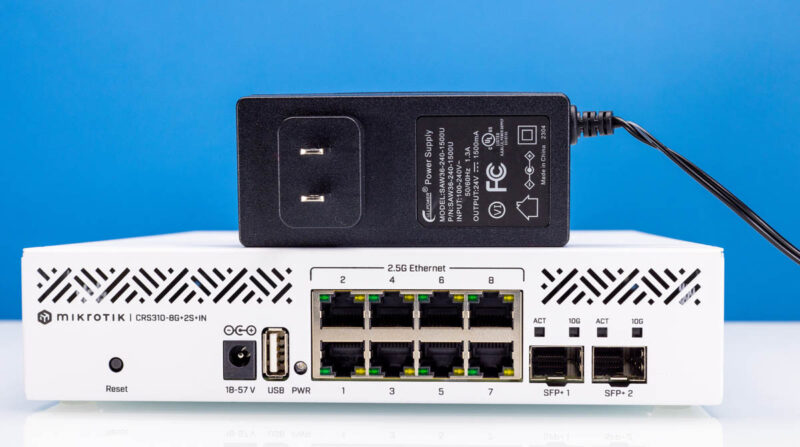
At idle, we saw around 10.5W.
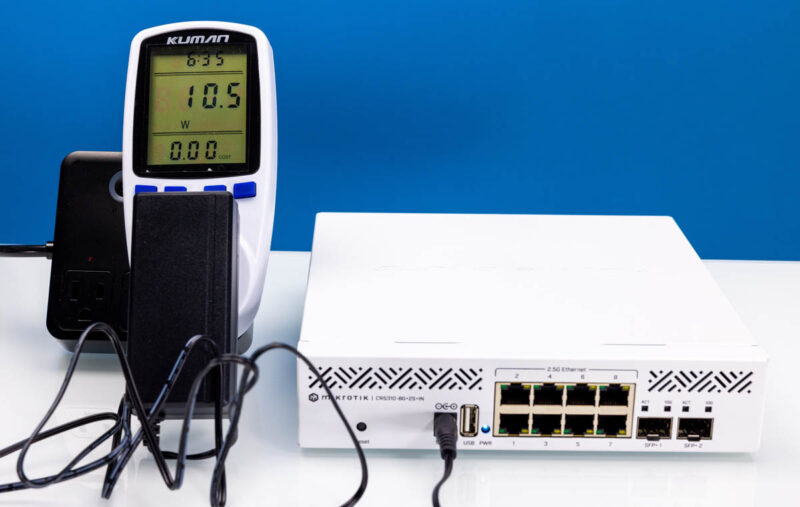
Adding a single 2.5GbE link added an incremental 1.0W.
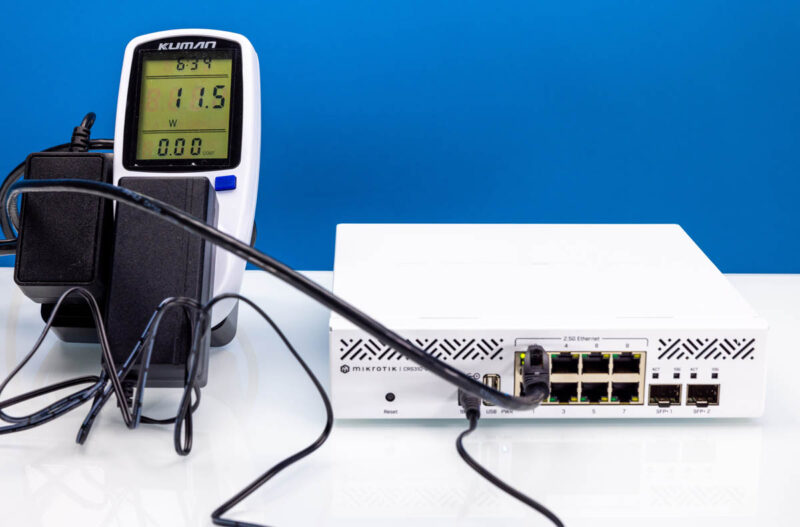
Using a SFP+ to 10Gbase-T adapter added about 1.4W.
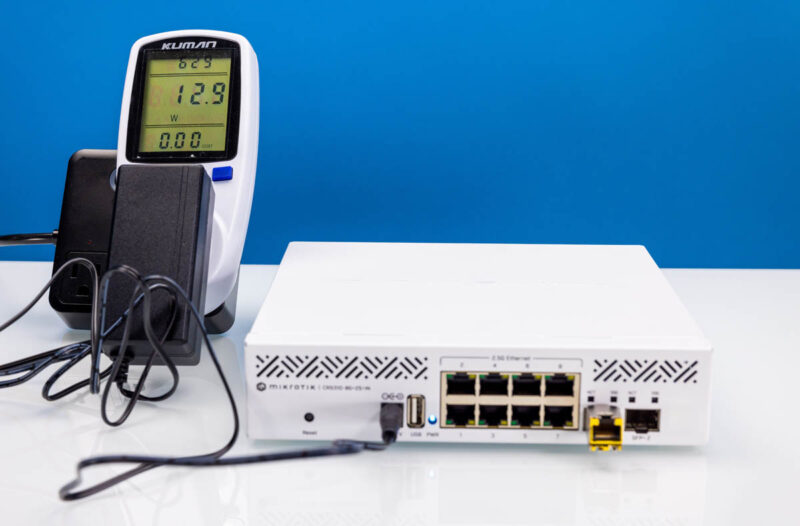
The spec sheet says the maximum power consumption, without attachments, is 21W, and the maximum power consumption is 34W. While this is managed, it is also much higher power than some of the other solutions we tested. It also includes a fan, so it is not a fanless model.
From a noise perspective, if you use this as a light-duty desktop switch, it will likely run silently or near silently. While it turns on, it will sound like a hairdryer and peak in the 43-46dba range. Patrick had this on the old STH Austin studio set with a 34.0dba noise floor, and we could not hear it. I will note, however, that I forgot the unit had fans, and when we loaded the switch up, and the fans spun, I was confused as to why the switch that had spent a week running silently suddenly was running at around 42dba.
Final Words
This is one of those switches that we have been waiting for or perhaps dreaming about for some time. New desktops, mini PCs, WiFi 6E APs, modems, and more have moved to 2.5GbE, and MikroTik has been stuck in the 1GbE generation. While we want to see an entire line refresh, this at least starts the process.
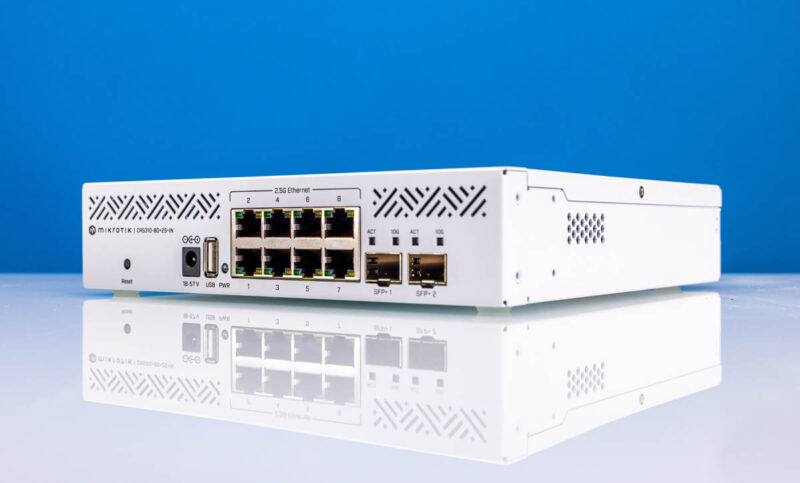
Clearly, though, MikroTik needs some help. Using the Marvell switch is great because it is a common platform the company has used for years. Unlike some cheaper switches based on Realtek unmanaged switch chips, MikroTik is dealing with much higher costs that limit just how inexpensive this switch can be. At some point, MiktoTik clearly made the decision to put small heatsinks and a fan in this instead of just passively cooling the switch.
The older Marvell switch chip is also not the most power-efficient, and that is fairly easy to see if you have been following our series. It feels like MikroTik needs to go to Marvell (or another vendor) and discuss next-gen switch chips. A challenge will be that most new switch chips use 64-bit Arm cores, so a newer chip might increase the switch chip cost and other costs, such as adding more DRAM. MikroTik at some point, needs to get a new platform for 2.5GbE switches as it moves up the stack. The company already has a 4-port 100GbE switch, the MikroTik CRS504-4XQ-IN, for $699. The CRS310-8G+2S+IN is $219 right now, so MikroTik can already offer 10x the bandwidth for only ~3x the price. It needs things like a 48-port 2.5GbE switch with 100GbE, a 24-port CRS326 replacement with 2.5GbE and 25GbE, and so forth. That does not happen alone, MikroTik needs a switch silicon partner, and hopefully, one that can also offer a bit more on the hardware offloading side.
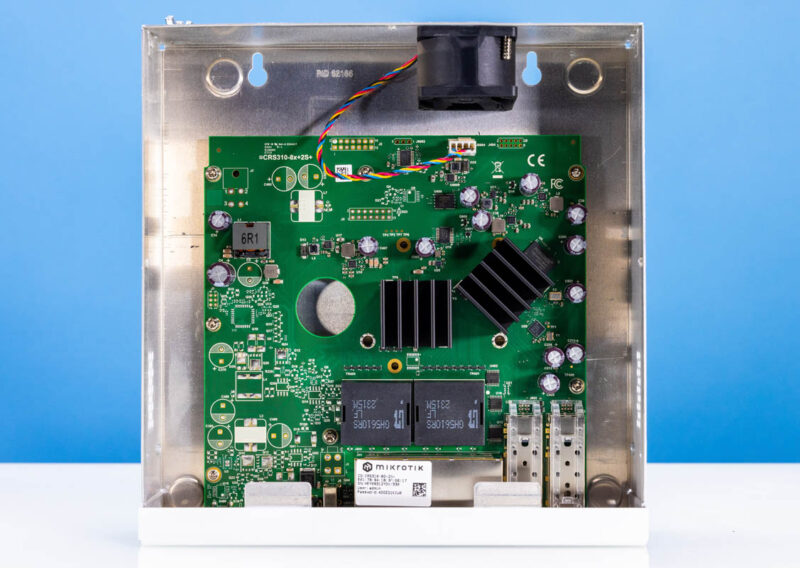
All of that, however, is feedback for a different day and where we hope the line expands in the future. Today, we have the MikroTik CRS310-8G+2S+IN that finally brings managed 2.5GbE networking to the desktop form factor and is offered by a company many have heard of before. Now that this dream is realized, we cannot wait to see what is next.
Where to Buy
Here is an Amazon Affiliate link to the switch. We may earn a small commission if you purchase through this link.
In the video, we also briefly showed the TP-Link 8-port 2.5GbE, PoE switch also with dual SFP+ as something we want to see in the future from MikroTik. You can find that link here.



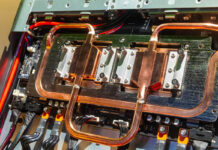
While this looks great I want a 24×2.5 2×25 to replace my 1/10 CRS. It’s been 5yrs. So it’s time the tech turns over
Honestly the cooling and the fan it’s a no go for me. I’ll just wait for the TP-Link SG3210X-M2.
Love it but really want to see an 8 port qsfp28 crs for Christmas, please St. Patrick.
It’s really a shame that on basically every network device review done by STH, there is a lack of proper throughout testing. Saying that a device achieves xx gigabit per second, without specifying packet size and total session counts is useless.
Packet size in particular is incredibly important, because the difference in packet counts needed to reach even just 1 gigabit per second between a 64 byte and a 9000 byte MTU is astronomical.
In 2024, we’re lucky to have some 2.5gbit sprinkle on us, while home wifi 7 routers, NASes are now mandatory 10gbit. I already upgraded computers to 25gbit, but of course, nowhere to switch them. It will take a decade probably to get what we really deserve: managed 2xSFP28+8x10gbit(or 4x10gbit,4×2.5gbit) switches for affordable price. At that time, moderate ISP speed will be 25gbit. Damn, 2.5gbit is just 300MBs if you think of it. That’s a shame for a local network. That’s like a floppy disc.
This would have been good if it had 2 wired ports instead of the SPF+. Most SOHO users don’t have fiber, and investing both time and money in it, to get cheap switches defies the point, as the connectors eat the savings.
Many smaller networks can be made with wired connections alone. Few come with fiber or the need for it.
This switch would be close to perfect with wired 10-Gb ports instead. Now one has to buy the switch and two modules to get wired 10GB, and the modules cost as much as 2/3 of the switch here in EU. Then it is not that cheap anymore. They should make one with wired 10Ge as prices of 10GB NICs are decreasing.
The competing unmanaged 4×2.5Gb 2x10Gb is 2/3 the cost her in EU.
A big brother could be one with 8x 1Gb, 8×2,5GB and 2-4 10GB, as that would cover 60-70% of use cases.
Mikrotik recently updated the firmware and made SwOS available for this switch. The upgrade and change to SwOS went smoothly. It did default to no administrator password, so added that afterwards.
If this had even one 2.5gbit PoE out port I’d buy two right now
Did Mikrotik ever release an update based on this PCB? Given that hole in the middle, and the additional component markings..
Trying to weight up if this is the device for me.. I have a small handful of 2.5GbE devices and considering 10gig for workstation + NAS
Otherwise I’m looking solely at the CRS305 and hopefully find a way of uplinking a seperate 2.5GbE switch into it..
And then I start to wonder about 25gig (for which I have no real need whatsoever lol)
Not yet.